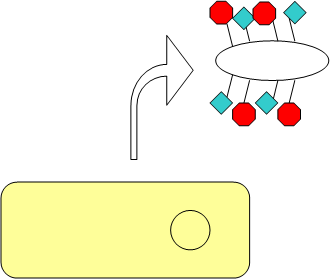Team:Edinburgh/Phage Reactors 1.0
From 2011.igem.org
(→Technical details) |
(→A modelling component) |
||
| Line 21: | Line 21: | ||
==A modelling component== | ==A modelling component== | ||
| - | This project has a natural modelling component. Cellulosomes contain several different enzymes that assist in the conversion of cellolose into sugar. It would be good to optimise what the ratio of these various enzymes should be. Modelling will be needed for investigation of other possible | + | This project has a natural modelling component. Cellulosomes contain several different enzymes that assist in the conversion of cellolose into sugar. It would be good to optimise what the ratio of these various enzymes should be. Modelling will be needed for investigation of other possible phage reactors as well. |
Revision as of 15:18, 22 June 2011
There exist situations where:
- several enzymes are needed to produce the desired product
- these enzymes work synergistically
- these enzymes must work outside the cell
This proposal allows for the construction of scaffolds containing several enzymes, as well as ensuring that this complex is exported from the cell. This is accomplished by using phage as the scaffold, and attaching enzymes to it by protein fusion.
There are probably many uses of an external reaction scaffold, so this technique is fairly general and could hopefully be used for many purposes, just by swapping in the correct BioBricks. One example is a [http://en.wikipedia.org/wiki/Cellulosome cellulosome], which is a complex of cellulolytic enzymes that can be used to turn cellulose (tough plant material) into sugar, which can then be fermented into fuel. This is something Chris is quite expert on, so could be a good fit for the lab.
Technical details
The project would probably use phage M13, which is non-lytic (does not kill the bacteria). The major coat protein (P8 aka PVIII) already exists in the Registry as <partinfo>BBa_M13008</partinfo>.
Proteins can be fused to P8 at its amino terminal (i.e. 5' end in the DNA).
To attach several different proteins to the resulting phage, different fusions can be created and all of them expressed on a plasmid. Chris notes that the presence of repeated sequences on a plasmid can lead to genetic instability, but this will not be a problem in lab strains, which lack an important recombination enzyme. As for the use of this technology in industry, it will be possible to overcome this problem simply by synthesising coding sequences with as many altered (but synonymous) codons as possible.
As proof of concept (i.e. something we can accomplish in a short time) it will suffice to get one protein attached to the phage, as long as we can assay for it being exported from the cell. Better would be to get two enzymes attached, which are both required to produce some assayable product.
A modelling component
This project has a natural modelling component. Cellulosomes contain several different enzymes that assist in the conversion of cellolose into sugar. It would be good to optimise what the ratio of these various enzymes should be. Modelling will be needed for investigation of other possible phage reactors as well.
This was the old Navbox for Edinburgh; now it's obsolete...
- Edinburgh 2011
- Project documentation: Project - BioSandwich - Parts - Modeling - Lab Notebook - Safety - Team - Attributions
- Pages for members: Wiki Watch - Useful Links - Sequences - Primers - Practices - Official Profile (has email addresses)
- (edit this navigation box)
 "
"
